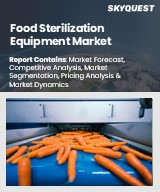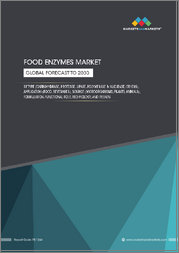
|
시장보고서
상품코드
1701524
세계의 차 시장 규모, 점유율, 성장 분석 : 유형별, 형태별, 카테고리별, 유통 채널별, 지역별 - 산업 예측(2025-2032년)Tea Market Size, Share, and Growth Analysis, By Type (Black, Green), By Form (Loose Leaf, Tea Bags), By Category, By Distribution Channel, By Region - Industry Forecast 2025-2032 |
||||||
차 세계 시장 규모는 2023년 215억 달러, 2024년 228억 5,000만 달러에서 2032년 372억 6,000만 달러로 성장할 것으로 예상되며, 예측 기간(2025-2032년) 동안 6.3%의 연평균 복합 성장률(CAGR)을 보일 것으로 예측됩니다.
국제 차 시장은 건강상의 이점과 맛의 다양성에 대한 소비자의 인식이 높아짐에 따라 지속적인 성장과 혁신이 이루어지고 있습니다. 독특한 경험을 원하는 소비자 수요를 반영하여 프리미엄 티와 스페셜티 티로의 전환이 두드러지게 나타나고 있습니다. 아시아, 특히 중국과 인도가 여전히 생산과 소비의 중심지이지만, 아프리카와 중남미 등 신흥 지역도 세계 시장에 큰 기여를 하고 있습니다. 허브티와 스페셜티의 인기 상승은 건강 지향적 트렌드와 일치하며, 특히 유럽과 미국 시장에서는 항산화 작용을 하는 녹차가 인기를 끌고 있습니다. 또한, 편리성이라는 요인은 바쁜 소비자들을 위해 바로 마실 수 있는(RTD) 차 제품을 촉진하고 있으며, 전자상거래는 다양한 차 제품에 대한 접근성을 향상시키고, 세계 거래를 촉진하며, 새로운 시장 기회를 열어주고 있습니다.
목차
서론
- 조사 목적
- 조사 범위
- 정의
조사 방법
- 정보 조달
- 2차와 1차 데이터 방법
- 시장 규모 예측
- 시장 전제조건과 제한
주요 요약
- 세계 시장 전망
- 공급과 수요 동향 분석
- 부문별 기회 분석
시장 역학과 전망
- 시장 개요
- 시장 규모
- 시장 역학
- 성장 촉진요인과 기회
- 성장 억제요인과 과제
- Porter의 Five Forces 분석
주요 시장 인사이트
- 중요 성공 요인
- 경쟁 정도
- 주요 투자 기회
- 시장 생태계
- 시장의 매력 지수(2024년)
- PESTEL 분석
- 거시경제 지표
- 밸류체인 분석
- 가격 분석
- 규제 상황
- 사례 연구
차 시장 규모 : 유형별
- 시장 개요
- 홍차
- 녹차
- 우롱차
- 허브차
- 기타
차 시장 규모 : 형태별
- 시장 개요
- 루스리프
- 티백
- 기타
차 시장 규모 : 카테고리별
- 시장 개요
- 오가닉
- 기존
차 시장 규모 : 유통 채널별
- 시장 개요
- 하이퍼마켓 및 슈퍼마켓
- 편의점
- 전문점
- 온라인
차 시장 규모
- 북미
- 미국
- 캐나다
- 유럽
- 독일
- 스페인
- 프랑스
- 영국
- 이탈리아
- 기타 유럽
- 아시아태평양
- 중국
- 인도
- 일본
- 한국
- 기타 아시아태평양
- 라틴아메리카
- 브라질
- 기타 라틴아메리카
- 중동 및 아프리카
- GCC 국가
- 남아프리카공화국
- 기타 중동 및 아프리카
경쟁 정보
- 주요 5개사 비교
- 주요 기업의 시장 포지셔닝(2024년)
- 주요 시장 기업이 채택한 전략
- 최근 시장 동향
- 기업의 시장 점유율 분석(2024년)
- 주요 기업 개요
- 기업 상세
- 제품 포트폴리오 분석
- 기업 부문별 점유율 분석
- 매출 전년대비 비교(2022-2024년)
주요 기업 개요
- Unilever(United Kingdom)
- Tata Consumer Products(India)
- Associated British Foods(United Kingdom)
- The Republic of Tea(United States)
- Numi, Inc.(United States)
- Bigelow Tea Company(United States)
- Tetley(India)
- Vahdam Teas(India)
- Harney & Sons(United States)
- Lipton(United Kingdom)
- Twinings(United Kingdom)
- Dilmah(Sri Lanka)
- Celestial Seasonings(United States)
- PG Tips(United Kingdom)
- Yorkshire Tea(United Kingdom)
- Teekanne(Germany)
- Teavana(United States)
- Harrods Tea(United Kingdom)
- Tazo Tea(United States)
- Numi Organic Tea(United States)
결론과 제안
LSH 25.05.22Global Tea Market size was valued at USD 21.5 billion in 2023 and is poised to grow from USD 22.85 billion in 2024 to USD 37.26 billion by 2032, growing at a CAGR of 6.3% during the forecast period (2025-2032).
The international tea market is thriving, characterized by continuous growth and innovation driven by increasing consumer awareness of health benefits and flavor diversity. There's a notable shift towards premium and specialty teas, reflecting consumer demand for unique experiences. While Asia, particularly China and India, remains central to production and consumption, emerging regions like Africa and South America are becoming significant contributors to the global market. The rising popularity of herbal and specialty teas aligns with health-conscious trends, with green tea gaining traction for its antioxidant properties, especially in Western markets. Moreover, the convenience factor is promoting ready-to-drink (RTD) tea products, catering to busy consumers. E-commerce has enhanced accessibility to varied tea offerings, fostering global trade and opening new market opportunities.
Top-down and bottom-up approaches were used to estimate and validate the size of the Global Tea market and to estimate the size of various other dependent submarkets. The research methodology used to estimate the market size includes the following details: The key players in the market were identified through secondary research, and their market shares in the respective regions were determined through primary and secondary research. This entire procedure includes the study of the annual and financial reports of the top market players and extensive interviews for key insights from industry leaders such as CEOs, VPs, directors, and marketing executives. All percentage shares split, and breakdowns were determined using secondary sources and verified through Primary sources. All possible parameters that affect the markets covered in this research study have been accounted for, viewed in extensive detail, verified through primary research, and analyzed to get the final quantitative and qualitative data.
Global Tea Market Segments Analysis
Global Tea Market is segmented by Type, Form, Category, Distribution Channel and region. Based on Type, the market is segmented into Black, Green, Oolong, Herbal and Others. Based on Form, the market is segmented into Loose Leaf, Tea Bags and Others. Based on Category, the market is segmented into Organic and Conventional. Based on Distribution Channel, the market is segmented into Hypermarkets & Supermarkets, Convenience Stores, Specialty Stores and Online. Based on region, the market is segmented into North America, Europe, Asia Pacific, Latin America and Middle East & Africa.
Driver of the Global Tea Market
A significant factor propelling the global tea market is the growing awareness among consumers regarding the health benefits associated with tea consumption. Particularly, green and herbal teas are viewed as healthier alternatives to sugary beverages such as sodas. Tea is abundant in antioxidants and offers various health advantages, including enhanced cardiovascular health, support for weight management, and a lowered risk of chronic diseases. As more individuals focus on health and wellness, the demand for tea as a natural and nutritious beverage is expected to rise. This trend highlights the shift toward healthier lifestyle choices among consumers worldwide.
Restraints in the Global Tea Market
The global tea market faces significant constraints due to climate change, which poses a considerable threat to tea cultivation. This industry relies heavily on specific climatic conditions, meaning that changes in temperature and precipitation patterns directly impact both yields and quality. Issues such as prolonged droughts, unpredictable weather, and a rise in pests and diseases can severely hinder production capabilities. Additionally, sustainability concerns surrounding land usage, water consumption, and pesticide residues may negatively affect the industry's reputation and limit access to markets with stringent regulations. Consequently, the tea industry must confront these sustainability challenges to thrive in a changing environment.
Market Trends of the Global Tea Market
The global tea market is experiencing a significant trend toward the increasing demand for specialty teas, driven by a growing consumer preference for unique and premium varieties. As health-consciousness rises, consumers are gravitating towards herbal, organic, artisanal blends, and single-origin teas that promise distinctive flavors and health benefits. This shift reflects a broader trend within the market, where discerning customers are willing to explore diverse categories, elevating the experience of tea consumption to new heights. The surge in interest for specialty teas is reshaping marketing strategies and product offerings, offering substantial opportunities for brands to innovate and connect with a more sophisticated consumer base.
Table of Contents
Introduction
- Objectives of the Study
- Scope of the Report
- Definitions
Research Methodology
- Information Procurement
- Secondary & Primary Data Methods
- Market Size Estimation
- Market Assumptions & Limitations
Executive Summary
- Global Market Outlook
- Supply & Demand Trend Analysis
- Segmental Opportunity Analysis
Market Dynamics & Outlook
- Market Overview
- Market Size
- Market Dynamics
- Drivers & Opportunities
- Restraints & Challenges
- Porters Analysis
- Competitive rivalry
- Threat of substitute
- Bargaining power of buyers
- Threat of new entrants
- Bargaining power of suppliers
Key Market Insights
- Key Success Factors
- Degree of Competition
- Top Investment Pockets
- Market Ecosystem
- Market Attractiveness Index, 2024
- PESTEL Analysis
- Macro-Economic Indicators
- Value Chain Analysis
- Pricing Analysis
- Regulatory Landscape
- Case Studies
Global Tea Market Size by Type & CAGR (2025-2032)
- Market Overview
- Black
- Green
- Oolong
- Herbal
- Others
Global Tea Market Size by Form & CAGR (2025-2032)
- Market Overview
- Loose Leaf
- Tea Bags
- Others
Global Tea Market Size by Category & CAGR (2025-2032)
- Market Overview
- Organic
- Conventional
Global Tea Market Size by Distribution Channel & CAGR (2025-2032)
- Market Overview
- Hypermarkets & Supermarkets
- Convenience Stores
- Specialty Stores
- Online
Global Tea Market Size & CAGR (2025-2032)
- North America (Type, Form, Category, Distribution Channel)
- US
- Canada
- Europe (Type, Form, Category, Distribution Channel)
- Germany
- Spain
- France
- UK
- Italy
- Rest of Europe
- Asia Pacific (Type, Form, Category, Distribution Channel)
- China
- India
- Japan
- South Korea
- Rest of Asia-Pacific
- Latin America (Type, Form, Category, Distribution Channel)
- Brazil
- Rest of Latin America
- Middle East & Africa (Type, Form, Category, Distribution Channel)
- GCC Countries
- South Africa
- Rest of Middle East & Africa
Competitive Intelligence
- Top 5 Player Comparison
- Market Positioning of Key Players, 2024
- Strategies Adopted by Key Market Players
- Recent Developments in the Market
- Company Market Share Analysis, 2024
- Company Profiles of All Key Players
- Company Details
- Product Portfolio Analysis
- Company's Segmental Share Analysis
- Revenue Y-O-Y Comparison (2022-2024)
Key Company Profiles
- Unilever (United Kingdom)
- Company Overview
- Business Segment Overview
- Financial Updates
- Key Developments
- Tata Consumer Products (India)
- Company Overview
- Business Segment Overview
- Financial Updates
- Key Developments
- Associated British Foods (United Kingdom)
- Company Overview
- Business Segment Overview
- Financial Updates
- Key Developments
- The Republic of Tea (United States)
- Company Overview
- Business Segment Overview
- Financial Updates
- Key Developments
- Numi, Inc. (United States)
- Company Overview
- Business Segment Overview
- Financial Updates
- Key Developments
- Bigelow Tea Company (United States)
- Company Overview
- Business Segment Overview
- Financial Updates
- Key Developments
- Tetley (India)
- Company Overview
- Business Segment Overview
- Financial Updates
- Key Developments
- Vahdam Teas (India)
- Company Overview
- Business Segment Overview
- Financial Updates
- Key Developments
- Harney & Sons (United States)
- Company Overview
- Business Segment Overview
- Financial Updates
- Key Developments
- Lipton (United Kingdom)
- Company Overview
- Business Segment Overview
- Financial Updates
- Key Developments
- Twinings (United Kingdom)
- Company Overview
- Business Segment Overview
- Financial Updates
- Key Developments
- Dilmah (Sri Lanka)
- Company Overview
- Business Segment Overview
- Financial Updates
- Key Developments
- Celestial Seasonings (United States)
- Company Overview
- Business Segment Overview
- Financial Updates
- Key Developments
- PG Tips (United Kingdom)
- Company Overview
- Business Segment Overview
- Financial Updates
- Key Developments
- Yorkshire Tea (United Kingdom)
- Company Overview
- Business Segment Overview
- Financial Updates
- Key Developments
- Teekanne (Germany)
- Company Overview
- Business Segment Overview
- Financial Updates
- Key Developments
- Teavana (United States)
- Company Overview
- Business Segment Overview
- Financial Updates
- Key Developments
- Harrods Tea (United Kingdom)
- Company Overview
- Business Segment Overview
- Financial Updates
- Key Developments
- Tazo Tea (United States)
- Company Overview
- Business Segment Overview
- Financial Updates
- Key Developments
- Numi Organic Tea (United States)
- Company Overview
- Business Segment Overview
- Financial Updates
- Key Developments



















